Montreal Bagels/Tradition vs. Modernity
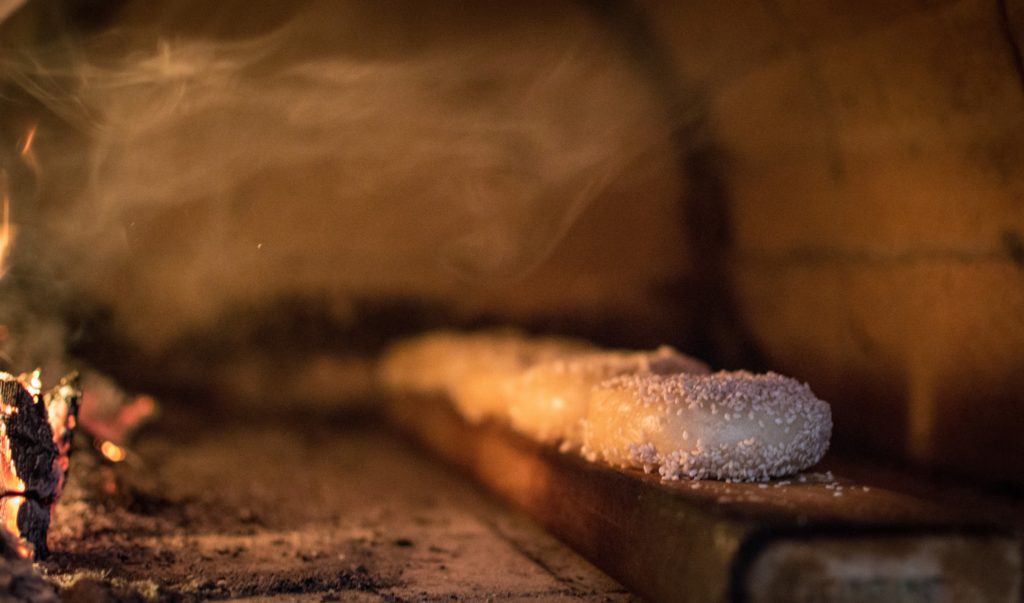
Montreal is an awesome culinary city. Fantastic ethnic restaurants, amazing outdoor food markets, and legendary chefs are just a few of the draws. On my visit to the city, I decided to stay in the Mile End neighborhood. This neighborhood at its roots was an industrial, working class borough. It’s very similar to Brooklyn in look and vibe– so much so that it has served as a stand-in for film productions set in New York. And like Brooklyn, Mile End has recently evolved into a hip and trendy ‘hood.

Formerly home to waves of Greek, Portuguese and Jewish immigrants, it now contains a thriving culture of musicians, artists, and writers. During my visit to this neighborhood there was really only one art form I was interested in: the Montreal Bagel. Luckily, despite the changes in the neighborhood in recent decades, two of the oldest and most famous bagel shops are still hand-rolling bagels in the Mile End: Fairmount Bagel and St. Viateur Bagel. Locals have a fierce loyalty to one or the other of these shops located just a couple of blocks from eachother. During my first trip to Montreal, I stumbled upon my favorite right away. It turns out, I’m on team St. Viateur. This is not because of a comparison of which bagel is fresher, chewier or sweeter and obviously not because of any deep-rooted family loyalty. Instead, it’s based on a great memory I will always have of my three-year-old connecting with people through food.
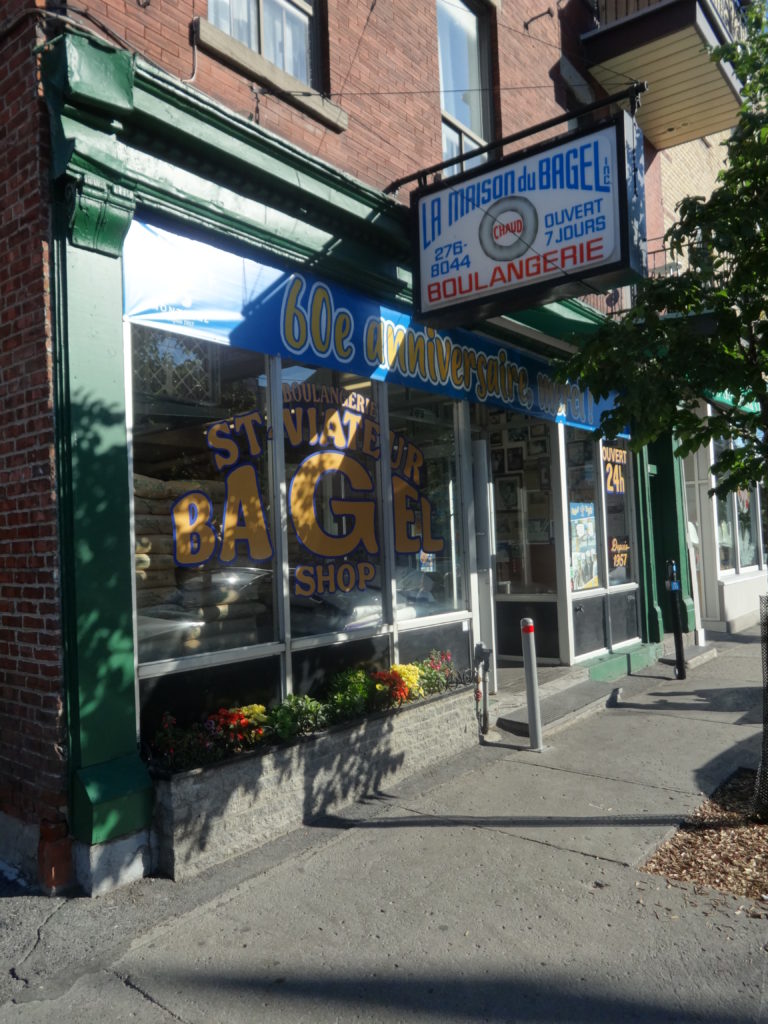
We had taken our place in a line that led partway down the block. Before long, my youngest had lost patience with waiting. When we noticed that she was no longer standing with us, in a panic, we scattered to find her. I hurried toward the door of St. Viateur and saw her pushing her way through people’s knees and into the shop. I managed to also push my way through behind her (as Canadians really are very polite and allowed me to pass), and followed her through the door. At the front of the line my daughter announced, “I NEED A BAGEL!” Without missing a beat, the tiny older woman sitting near the register said, “Ahhh, yes–you come here you little sweetie, I’ll get you a bagel!” She took Natalia’s hand and led her over to where the mountains of glistening dough rings, having just emerged from their honey bath, were rolled into sesame seeds and lined up on a long board-ready to be baked. She plucked a bagel from those just being tossed from the fragrant, wood-burning oven and handed it to my daughter. My daughter, smiling broadly, took the bagel from her but it promptly slipped through her small fingers to the floor. I watched her face drop, but the woman simply grabbed another, handed it to her and told her not to worry-just enjoy! They hugged and my daughter sat down next to her, nibbled her bagel and smiled up at me.
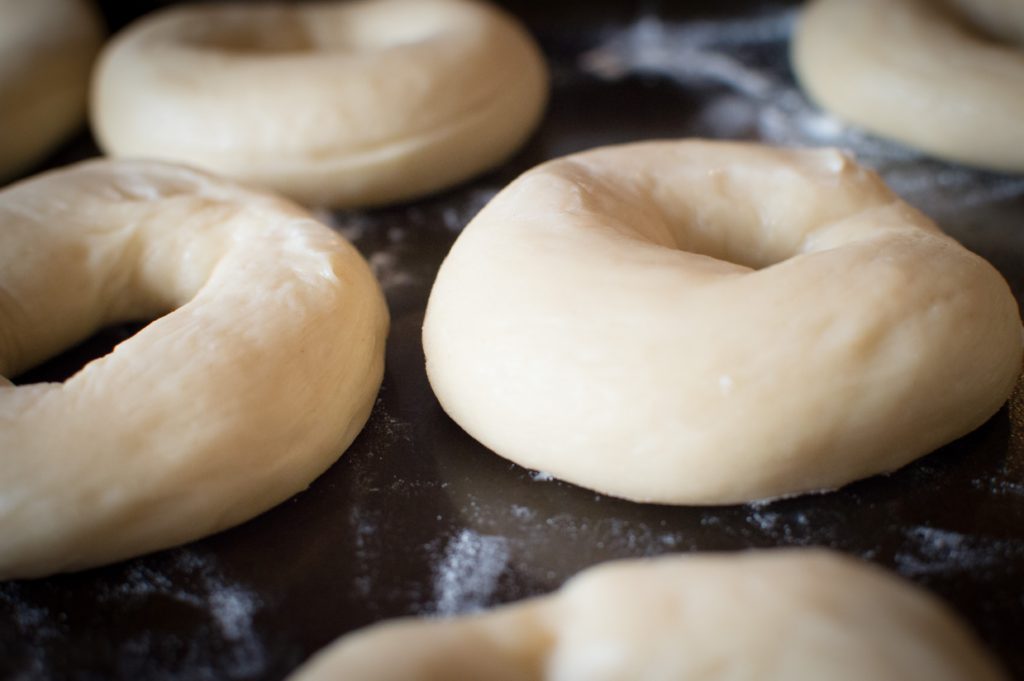
As if that wasn’t enough to make me a loyal devotee of St. Viateur, the bagel then handed to me locked me in. It was crisp but tender on the outside, with a generous coating of fragrant sesame seeds. Inside, it is smaller and denser than a New York bagel, yet still light and airy. And the flavor, in my opinion, is so much better. It’s subtly sweet and malty. My daughter, now happily chatting with her new friend, had opened up the opportunity for us to ask her about how Montreal bagels are made.
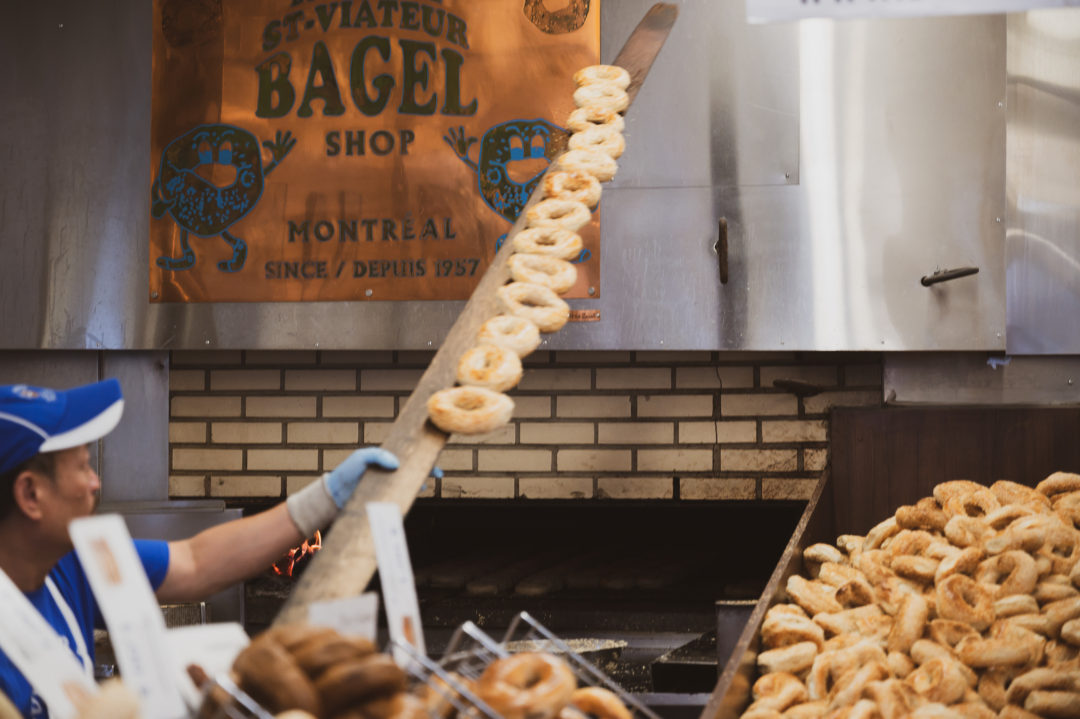
Something I thought I understood about Montreal bagels is that what helps to give them that perfect texture is the wood oven. Just like the neighborhood, though, it seems that the winds of change are coming for the wood-fired oven. We learned that any new bagelry in the city needed to have a hybrid wood/gas oven to help reduce the emissions. And now, it looks like people living near the shops were complaining of soot and poor air quality, and not being able to open their windows in the summer. Talk about wood ovens being banned entirely has begun. Could this be the death of the fire-cooked bagel? What about wood oven pizzas? The horror. Environmentalism vs. Tradition is in battle here, and I really am torn. On one hand, I am mourning the possible loss of the primal connection as well as the delicious results of cooking with fire. On the other hand, we understand better the effects on the environment and on people’s health and that’s difficult to ignore.
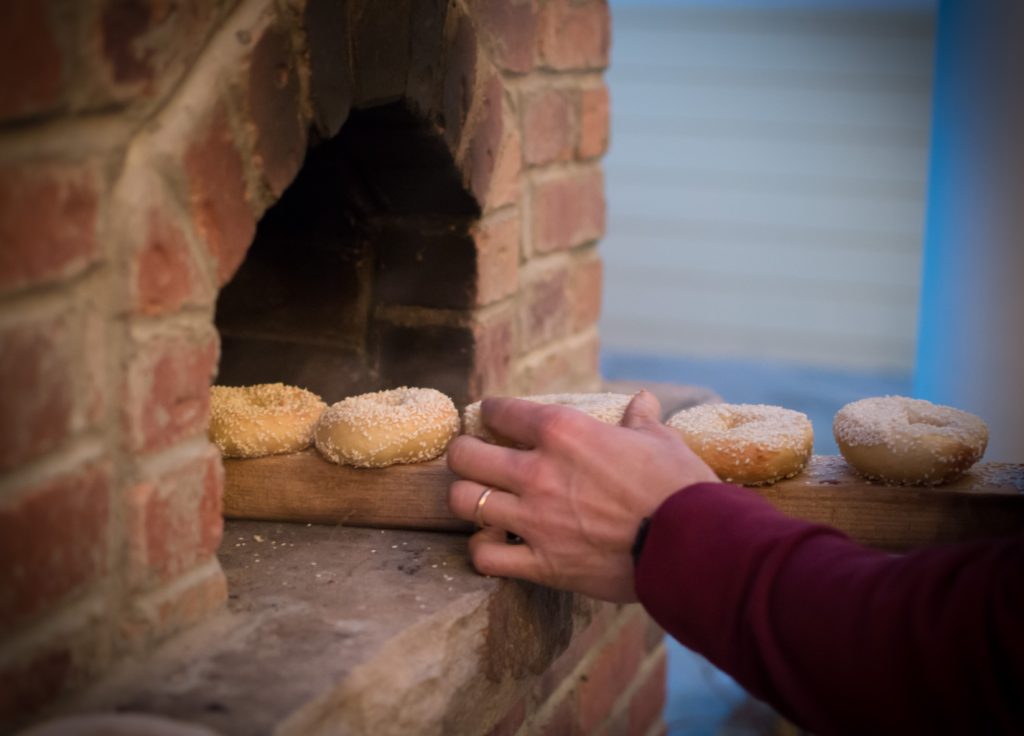
It so happens that in my backyard, I have a wood-burning oven. One of the reasons I decided to have it built was so that I could re-create Montreal bagels at home. It hasn’t been banned here yet, so I will continue to cook with fire until that happens. However, you can definitely achieve really good results in a regular oven as well. This is great for those who do not have access to a wood-fired oven, and for those of us who may be forced to abandon this way of cooking for the sake of progress. Either way, here is a recipe adapted from a 1987 New York Times article that will have you enjoying these at home until you can make it to Montreal.
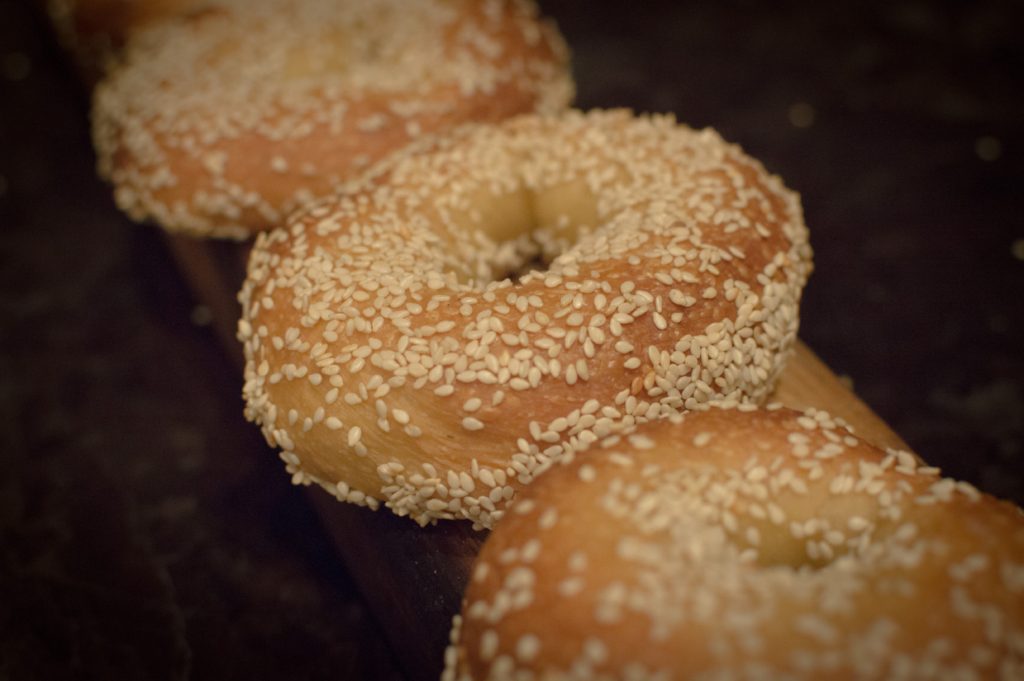

Montreal Bagels
Ingredients
- 1 1/2 cups lukewarm water
- 2 pkgs dry quick-rising yeast
- 1 tsp sugar
- 2 1/2 tsp sea salt
- 1 whole egg
- 1 egg yolk
- 1/4 cup vegetable oil
- 1 cup honey, divided
- 5 cups double zero or high gluten flour plus more for dusting
- 3 cups sesame seeds for coating may vary, of course
Instructions
- In a large mixing bowl or in the bowl of an electric mixer, blend together the water, yeast, and sugar. Stir in the whole egg, the yolk, oil and 1/2 cup honey, and mix until incorporated. Allow the mixture to rest for about 10 minutes while the yeast becomes foamy.
- Add the 5 cups high-gluten flour and the salt, and mix until the dough begins to get stiff. Use a rubber spatula to transfer to a lightly floured work surface (if using electric mixer, attach dough hook and add a little bit of flour until is can move around the bowl), and knead about 8-10 times to form a soft, supple dough. Add a bit more flour as needed to prevent dough from getting too sticky. It should feel like a powdered baby’s bottom.
- When the dough is smooth and elastic, place it in a lightly oiled bowl, and cover the bowl with a sheet of plastic wrap. Let rest for about 20-30 minutes.
- After it has rested, take a piece of dough from the bowl and stretch it. If it stretches easily and does not break right away, it’s ready to be rolled. If not, put it back in the bowl and let it rest until it passes this “window pane” test. You should almost be able to see light through the dough as you stretch it before it breaks.
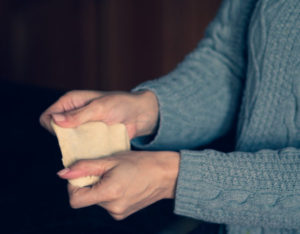
- When ready, slice your dough into thick strips. Roll each strip into a long rope-like shape until it is about 3/4 inch thick.
- To shape your bagels, pick up a piece of the end of one of your dough ropes and, while holding it, rotate your hand around so that the dough wraps around your hand, creating a ring. Break off the dough where the end will overlap, then rotate your hand back to your board and roll the dough gently with your palm until the seams seal. Be sure not to flatten the ring or change the shape. It’s important that it seals well at this point or it will unwrap when you boil them. Repeat with the remainder of your dough until all are shaped into rings.
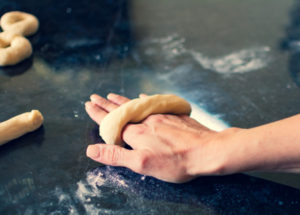
- Place the rings onto very lightly floured baking sheets and cover with plastic wrap. Refrigerate for 24-48 hours. This step really is important, as it allows for slow fermentation, which develops the flavors of the bagels more fully and gives them more structure.
- Leave bagels in the refrigerator while you prepare the following: preheat oven to 450 degrees and fill a large dutch oven or pot halfway with water and bring to a boil. Have a bowl of sesame seeds close by. Remove the bagels from the refrigerator now, and using a large slotted spoon, add three or four bagels to the boiling water. As they rise to the surface, turn them over, and let them boil an additional minute before removing them and quickly dipping them in the bowl of the seeds. Leave some area on the sides without seeds so that you can see the browning while baking. Working in batches, get the bagels into the oven as quickly as you can after seeding them. Place them on an ungreased baking sheet or a pre-heated pizza stone.
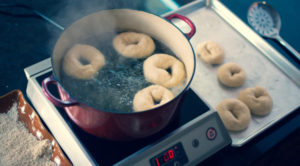
- In a wood-burning oven, use a bagel board made specifically for wood-oven bagel making, (link to purchase below), or alternately, DIY by wrapping a 2×4 with burlap. Line the bagels on the wood and carefully watch and rotate the bagels to get an even bake. They take roughly 5-7 minutes to cook in the wood oven. In a conventional oven, put a baking sheet with water on the bottom rack to keep them moist and help create a crispy skin. Bake until medium brown, about 25 minutes.

1 thought on “Montreal Bagels/Tradition vs. Modernity”